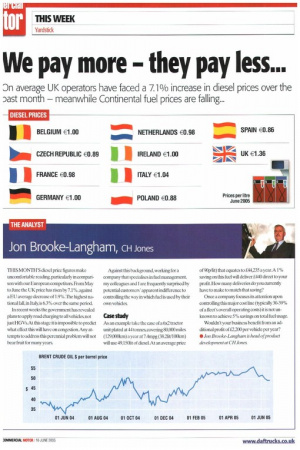Jon Brooke-Langham, CH Jones
Page 28

If you've noticed an error in this article please click here to report it so we can fix it.
THIS MONTH'S diesel price figures make uncomfortable reading, particularly in comparison with our European competitors .From May to June the UK price has risen by 7.1"/c.. against a EU average decrease of 1.9% The highest national fall,in Italy,is 6.3% over the same period.
In recent weeks the government has revealed plans to apply road charging to all vehicles, not just HGVs. At this stage it is impossible to predict what effect this will have on congestion. Any attempts to address this perennial problem will not bear fruit for many years Against this background, working for a company that specialises in fuel management, my colleagues and I are frequently surprised by potential customers' apparent indifference to controlling the way in which fuel is used by their own vehicles
Case study
As an example take the case of a 6x2 tractor unit plated at 44 tonnes, covering 80,000 miles (1 29,000km) a year at 7Ampg (38.2lit/1 00km) will use 49,1501it of dieseL At an average price of 90p/lit) that equates to £44,235 a year. A 1% saving on this fuel will deliver £440 direct to your profit. How many deliveries do you currently have to make to match that saving?
Once a company focuses its attention upon controlling this major cost line (typically 30-39% of a fleet's overall operating costs) it is not unknown to achieve 5% savings on total fuel usage.
Wouldn't your business benefit from an additional profit of £2200 per vehicle per year?
• Jon Brooke-Langham is head of product development at CH Jones.








































































































































































































